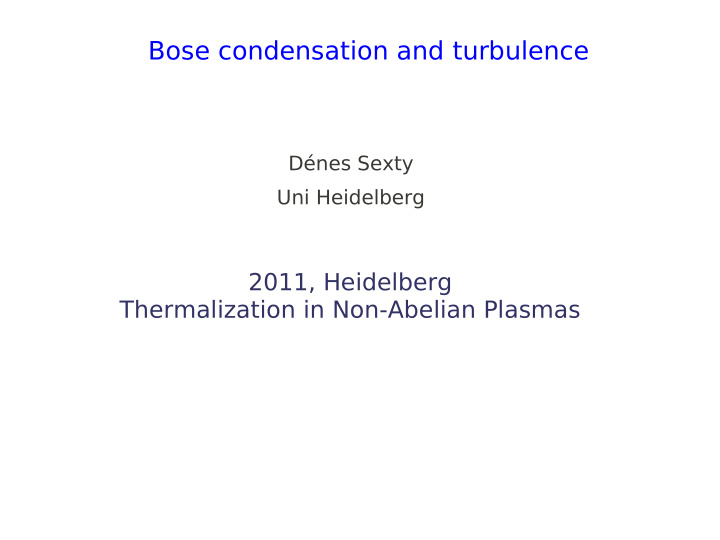



Bose condensation and turbulence Dénes Sexty Uni Heidelberg 2011, Heidelberg Thermalization in Non-Abelian Plasmas
Classical-statistical field theory n p ~ 1 1 ≫ n ≫ 1 n p 1 over-populated classical-particles quantum Classical statistical field theory Kinetic regime Effectively 2 to 2 Using 1/N resummation Wave turbulence exponents Strong turbulence exponents
What is a condensate? 3 k N = V ∫ d 1 = 0 In equilibrium: Maximum at k − − 1 3 2 e N N max Condensation: N 0 Condensate fraction Macroscopic occupation of the zero mode N 3 k n 0 n' k n k = Particle distribution: F x, y ={ x , y } In terms of 2point function n k = F k k ⇒ F k = 0 ~ V = ∫ d 3 x x 2 = F k = 0 condensate Independent of the volume V V
Condensation in bose gas x ,t Non relativistic scalars described by complex field i ∂ t x ,t = − ∂ i 2 x ,t 2 2 m g ∣ x ,t ∣ Gross-Pitaevski equation: 3 x ∣ x ,t ∣ n tot = ∫ d 2 conserved particle number occupation in zero mode: condensate = ∣ ∫ d 3 x x ,t ∣ 2 V
Non-equilibrium Bose condensation O(4) massless relativistic scalars Initial conditions: overpopulation = 〈 ∫ d 〉 ens 3 x a x 2 condensate V
Turbulent cascade Conserved charge Stationary power law solution ∂ k n k = 0 with k-independent flow 2->2 dominates: particle number effectively conserved Dual cascade: particles to IR energy to UV Particle flow Energy flow IR = d 1 or IR = d 2 UV = d − 2 or UV = d − 3 / 2 − n k ~ k
Gauge theory turbulence Pure SU(2) gauge theory overpopulated initial condition − 1.5 n p ~ p same as scalar UV exponent Dispersion
Kolmogorov Turbulence F x , y ={ x , y } In terms of corrleation functions a = a or A x , y =[ x , y ] Stationarity condition: p F p − F p p = 0 (Collision integral vanishes) p With self energy: − 2 − F , p z , s p = ∣ s ∣ F s Scaling ansatz 2 − , p z ,s p = ∣ s ∣ s F p ≫ p Classicality condition
p = ∫ qkl G q G k G l 4 p q k l Classical part of the stationarity condition: 0 = ∫ p qkl V p,q ,k ,l 4 p q k l [ F p F q F k l 2 F p F q k F l F p q F k F l Zakharov transformation: p F q F k F l ] swapping momenta l ' = p ; p' = l ; k ' = k ; l ' = l F p F q F k l ⇒ p F q F k F l 0 = ∫ p q k l V p ,q , k ,l 2 4 p q k l p F q F k F l [ 1 ∣ ] q 0 ∣ ∣ k 0 ∣ ∣ l 0 ∣ p 0 sgn p 0 p 0 sgn p 0 p 0 sgn p 0 Solutions: q 0 k 0 l 0 =− 1 = 5 3 and = 4 On shell limit = 0 3 2->2 dominates
IR resummation – Strong turbulence 1/N resummation: effective vertex p = ∫ kql eff p q G q G k G l 4 p q k l With one loop bubble: eff p = R p 1 A p 1 p = ∫ q G p G p − q The vertex scales: p ≫ 1 In the IR: 2r eff p with r = 3 − d eff s p = s sp = p eff = In the UV: = 4 or 5 (in d=3) Strong turbulence in the IR:
From 2PI to kinetic equations Using Wigner coordinates 4 s exp − ip s F p X = ∫ d F X s / 2 , X − s / 2 Gradient expansion, spatially homogeneous ensemble: ∂ t p X = 0 F X p X X F p X − p 2 p 0 ∂ t F p X = p Define: F p X = n p X 1 / 2 p X ∞ dp 0 n eff t , p = ∫ 0 2 2 p 0 p X n p X On-shell limit, only 2->2 contributes ∂ t n eff t , p = ∫ d 2 2 [ 1 n p 1 n l n q n r − n p n l 1 n q 1 n r ] eff p l n ≫ 1 Effective kinetic description valid at
Turbulence in d=4 UV = d − 3 IR = d 1 2
Conclusions Scalar case well understood Dual cascade Condensation Weak and strong exponents from kinetic theory (with resummation) Gauge theory Gauge fixing necessary UV exponent 3/2 condensation?
Time dependence of gauge theory exponent
Recommend
More recommend